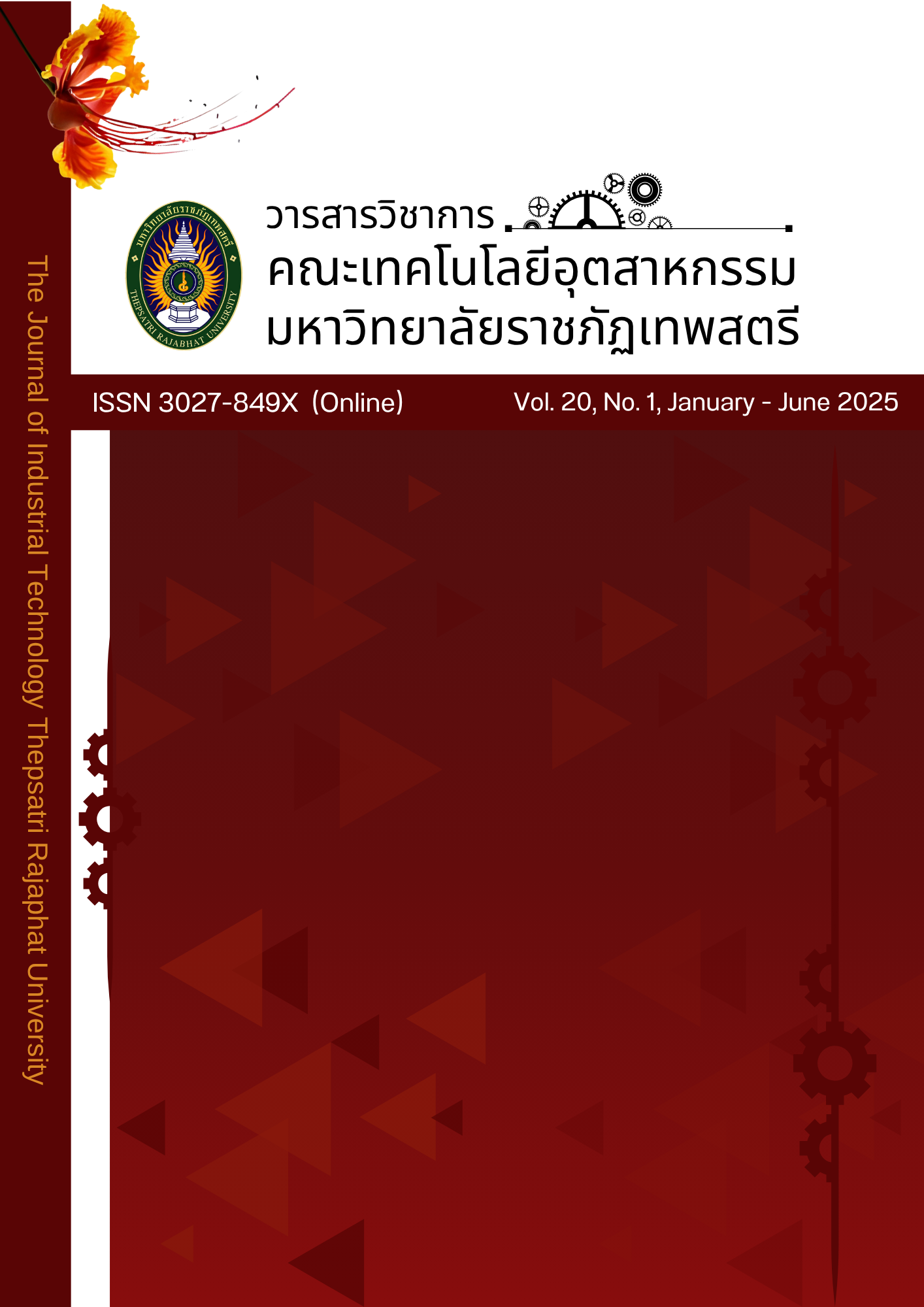การลดความสูญเสียในการผลิตชิ้นส่วนรถยนต์ด้วยการออกแบบอุปกรณ์ ช่วยป้องกันความผิดพลาดโดยการประยุกต์ใช้แนวคิดโพคา-โยเกะ
Loss Reduction in a automotive Part Manufacturing Through POKA-YOKE-Based Eror-Prevention Device Design
Abstract
งานวิจัยนี้มีเป้าหมายเพื่อวิเคราะห์และแก้ไขปัญหาการเกิดของเสียในกระบวนการผลิตชิ้นส่วนแผ่นรองรับท่อน้ำมันเชื้อเพลิง ของบริษัทผู้ผลิตชิ้นส่วนยานยนต์รายหนึ่ง ปัญหาหลักที่พบคือการเชื่อมโบลท์ (Bolt) ผิดตำแหน่งในกระบวนการเชื่อมจุด ส่งผลให้ปริมาณของเสียเฉลี่ยในช่วง 6 เดือนก่อนการปรับปรุงอยู่ที่ 52.85 PPM ซึ่งสูงเกินมาตรฐานที่บริษัทกำหนดไว้ไม่เกิน 10 PPM ถึง 428.5% การวิเคราะห์สาเหตุที่แท้จริงของปัญหาใช้หลักการ 3 จริง ได้แก่ สถานที่จริง สถานการณ์จริง และชิ้นงานจริง ร่วมกับเทคนิคการตั้งคำถาม ทำไม ทำไม พบว่าสาเหตุหลักมาจากการขาดอุปกรณ์ช่วยป้องกันความผิดพลาดในการทำงาน ที่ช่วยควบคุมตำแหน่งโบลท์ระหว่างการเชื่อม ผู้วิจัยใช้เทคนิคการตั้งคำถาม 5W1H ช่วยวิเคราะห์ซ้ำเพื่อกำหนดแนวทางการแก้ไข ผลการวิเคราะห์นำเสนอให้มีการออกแบบอุปกรณ์ป้องกันความผิดพลาดในขั้นการใส่โบลท์เชื่อมจุด และอุปกรณ์ป้องกันความผิดพลาดในการตรวจสอบคุณภาพที่มีระบบเซ็นเซอร์กึ่งอัตโนมัติสำหรับตรวจสอบตำแหน่งโบลท์แบบเรียลไทม์ หลังจากนำมาทดลองใช้งานจริงพบว่า ปริมาณของเสียลดลงจาก 52.85 PPM เหลือ 0 PPM ทำให้การตรวจจับข้อผิดพลาดมีความแม่นยำขึ้นจาก 85% เป็น 100% และสร้างความพึงพอใจของลูกค้า จากการลดปัญหาการเคลมงาน นอกจากนี้ยังสามารถปรับปรุงเอกสารมาตรฐานการปฏิบัติงานในรายละเอียดที่ยังไม่ถูกกำหนด เพื่อให้มั่นใจว่าพนักงานสามารถใช้อุปกรณ์ได้อย่างถูกต้องครบถ้วนตามขั้นตอน และมีประสิทธิภาพ การปรับปรุงครั้งนี้แสดงให้เห็นถึงประสิทธิภาพของ อุปกรณ์ป้องกันความผิดพลาดในการทำงาน ในการเพิ่มคุณภาพและลดของเสียได้อย่างมีนัยสำคัญ
References
L. Roca-Ramos, P. Vargas-Zamalloa, E. Carvallo-Munar, R. Salas-Castro, and L. Cardenas-Rengifo, “Poka-Yoke model for controlling unit entering and fall reduction in the transportation of toilets,” in Proc. 11th Int. Conf. Intelligent Human Computer Interaction (IHCI 2019), N. Jain, N. Tiwari, and A. Joshi, Eds. Lecture Notes in Computer Science, Allahabad, India, December.12-14, 2019, pp. 423–431.
J. Prokopenko, Productivity Management: A Practical Handbook. Geneva: International Labour Office, 1987.
R. Berndt, “Decision Diagrams for the Verification of Consistency in Automotive Product Data,” Ph.D.dissertation,Friedrich-Alexander-Universität Erlangen-Nürnberg, Universitätsbibliothek Erlan- gen-Nürnberg, 2016.
M. Imai, Kaizen: The Key to Japan's Competitive Success. New York: McGraw-Hill Education, 1986.
J. P. Womack and D. T. Jones, Lean Thinking: Banish Waste and Create Wealth in Your Corporation. New York: Simon & Schuster, 1996.
D. Maryadi, A. Azrin, and S. Suhendra, “Improving manufacturing productivity using lean manage- ment techniques: A case study approach,” J. Ind. Eng. Manag., vol. 17, no. 2, pp. 123-134, 2024.
J. K. Liker, The Toyota Way: 14 Management Principles from the World's Greatest Manufacturer. New York: McGraw-Hill Education, 2004.
A. Apriani, “Production Efficiency Improvement in Furniture Industry Using 5W1H Technique,” Master’s thesis, Universitas Mercu Buana, Jakarta, 2024.
K. Yamamoto, M. Milstead, and R. Lloyd, “A review of the development of lean manufacturing and related lean practices: The case of Toyota production system and managerial thinking,” Int. Manag. Rev., vol. 15, no. 2, pp. 21–40, Jan.2019.
H. Kelendar, “Lean thinking from Toyota manufacturing to the healthcare sector,” Res. Med. Eng. Sci., vol. 8, no. 5, pp. 913–926, Apr.2020.
M. Lazarevic, J. Mandic, and N. Sremcev, “A systematic literature review of Poka-Yoke and novel approach to theoretical aspects,” Stroj. vestn. – J. Mech. Eng., vol. 65, no. 7-8, pp. 454–467, July.2019.
H. H. Purba, F. A. Tosa, and Y. Santoso, “Using Poka-Yoke method for detection defect product in assembly component automotive,” J. Ind. Eng. Manag., vol. 12, no. 3, pp. 456–467, 2019.
R. F. Prabowo and S. Aisyah, “Poka-Yoke method implementation in industries: A systematic literature review,” Indones. J. Ind. Eng. Manag., vol. 1, no. 1, pp. 12–24, Feb.2020.
D. Bubber, G. Babber, and R. K. Jain, “Implementing lean tool: Poka-Yoke in tractor component manufacturing industry,” Int. J. Sci. Tech. Dev., vol. 8, no. 2, pp. 46–55, Dec.2022.

